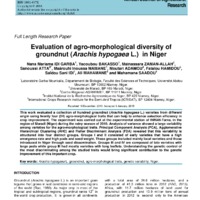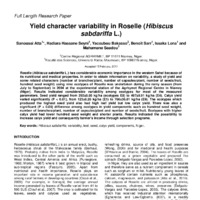Recherche
2 items
Evaluation of agro-morphological diversity of groundnut (Arachis hypogaea L.) in Niger
This work evaluated a collection of hundred groundnut (Arachis hypogaea L.) varieties from different origin using twenty four (24) agro-morphological traits that can help to enhance selection efficiency in crop improvement. The experiment was carried out at the experimental station of INRAN-Tarna, in the region of Maradi (Niger) during the rainy season of 2010. Analysis of variance showed a large variability among varieties for the agro-morphological traits. Principal Component Analysis (PCA), Agglomerative Hierarchical Clustering (AHC) and Fisher Discriminant Analysis (FDA) revealed that this variability is structured into four distinct groups. Groups I and II consisted of early varieties that have a high emergence rate and high pods and seed weight. These groups included mainly local varieties and those introduced in Niger through seed dissemination. Groups III and IV are composed of late varieties with large pods while group III had mostly varieties with long leaflets. Understanding the genetic control of the most discriminating among the studied traits would bring significant contribution to the genetic improvement of this important crop.
Yield character variability in Roselle (Hibiscus sabdariffa L.)
Roselle (Hibiscus sabdariffa L.) has considerable economic importance in the western Sahel because of its nutritional and medical properties. In order to obtain information on variability, a study of yield and some related characters (number of branches/plant, number of capsules/plant, number of seeds/fruit, hundred seed weight) using nine ecotypes of Roselle was undertaken during the rainy season (from July to September) in 2004 at the experimental station of the Agrhymet Regional Centre in Niamey (Niger). Results indicated considerable variability among ecotypes for most of the measured parameters. Seed yield ranged from 292±8.80 kg/ha (ecotypes E8) to 497±8.91 kg/ha (E4). Calyx yield varied significantly (P < 0.01), from 123±8.26 kg/ha (E1) to 766±36.81 kg/ha (E9). The ecotypes which produced the highest seed yield also had high leaf yield but low calyx yield. There was also a significant (P < 0.05) difference among ecotypes in yield components such as hundred seed weight, number of branches/plant, number of capsules/plant and number of seeds/fruit. Ecotypes with higher calyx yield had lower hundred seed weight and shorter plants. Results indicated the possibility to increase calyx yield and consequently farmer’s income through selection programs.

